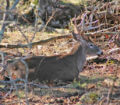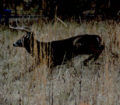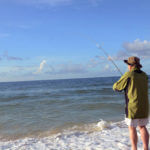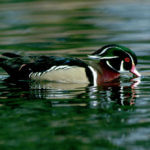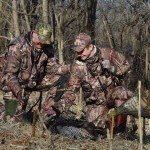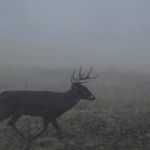Editor’s Note: If you put deer attractants along the edges of trails that deer use every day, they don’t have to find the attractants but will pass by them regularly. You’ll see more deer at your deer attractant sites next to trails, than if you just put an attractant out in the middle of the woods where there’s no deer sign at all.
 Apartment buildings, hotels and department stores all have fire escapes. Even elevators have trapdoors in their ceilings. Then, in case of an emergency, people have a way to escape danger. The whitetail may recognize the presence of danger in his environment, especially during hunting season. That’s why the buck has certain pre-determined paths he uses to escape danger. Oftentimes these trails won’t be well-defined and may show little wear. But they are the routes through the wilderness that bucks especially will use to dodge hunters.
Apartment buildings, hotels and department stores all have fire escapes. Even elevators have trapdoors in their ceilings. Then, in case of an emergency, people have a way to escape danger. The whitetail may recognize the presence of danger in his environment, especially during hunting season. That’s why the buck has certain pre-determined paths he uses to escape danger. Oftentimes these trails won’t be well-defined and may show little wear. But they are the routes through the wilderness that bucks especially will use to dodge hunters.
One of the most-unusual escape trails a hunting friend of mine ever discovered was under a bridge. Each morning before hunting season when that hunter was scouting on a club, he noticed a nice-sized buck in a green field. However, when the season arrived, he rarely saw the buck in the field but would spot him on the opposite side of the creek at first light as he went into the woods to hunt. After scouting for several weeks, the hunter still couldn’t pinpoint how the buck was getting away from the field to the opposite side of the creek. Finally, one morning, he left to hunt somewhat earlier, and the buck apparently was a little late leaving the green field. The hunter watched as the buck walked under the bridge hunters traveled across to go hunting. When daylight came, he found the buck’s trail where it went into the water just below the field. Checking under the bridge, he saw a small sandbar with plenty of tracks going both ways that the buck used to travel back and forth to the field. The hunter told a friend of his about this escape route, and the following morning, the friend took a stand near there but missed the buck.
As hunting pressure builds, and deer become more aware of the hunter’s presence in the woods, finding these escape trails, often in heavy cover or in unusual places, can be highly productive for deer hunters. One of the tricks to hunting these escape trails successfully is to understand how to make deer use them and how to stop deer that are coming down these trails.
 One of the best end-of-the-season tactics is a silent man-drive. One hunter starts upwind of a thick-cover region that bucks may be using during daylight hours. He walks a zigzag pattern back and forth upwind of that thick cover as quickly as possible, only occasionally stopping to break a limb. The driver wants his human odor to push the deer out of the cover. The reason he stops to break a stick is so that the deer can hear him, as well as smell him; however, since the only sound the deer hears is one small stick breaking, the deer can’t pinpoint with his ears the direction that the hunter is moving and only has his nose to tell him that the other deer is getting closer. Most of the time older-age-class bucks will sneak-out of thick cover, rather than bolt and run-out of thick cover.
One of the best end-of-the-season tactics is a silent man-drive. One hunter starts upwind of a thick-cover region that bucks may be using during daylight hours. He walks a zigzag pattern back and forth upwind of that thick cover as quickly as possible, only occasionally stopping to break a limb. The driver wants his human odor to push the deer out of the cover. The reason he stops to break a stick is so that the deer can hear him, as well as smell him; however, since the only sound the deer hears is one small stick breaking, the deer can’t pinpoint with his ears the direction that the hunter is moving and only has his nose to tell him that the other deer is getting closer. Most of the time older-age-class bucks will sneak-out of thick cover, rather than bolt and run-out of thick cover.
Therefore, if you set-up an attractant site about 100- to 150-yards down the escape trail that you expect the buck to use, there’s a very-good chance that when that buck sneaks out of the cover and starts coming down that escape trail, he’ll stop and eat the attractant, giving you the opportunity for a shot. When driving deer, most hunters think that the more noise they make, the more deer they can drive. However, an older-age-class buck often will lie in thick cover where he can’t be seen. There have been many cases where drivers have walked right past bucks, while making a lot of noise, because the bucks knew the drivers couldn’t see them and allowed the drivers to yell, holler and walk past them. However, when a deer can smell human odor and knows there’s a hunter approaching but can’t pinpoint the direction in which the hunter’s walking (like he can if the driver’s yelling and hollering), then that insecurity will cause the deer to get-up and start sneaking out of his thick-cover hideout. Because the deer moves early enough, he realizes he’ll have a chance to get to the attractant, especially if it’s on the edge of his escape trail, before he moves further away from the driver.

 Once you take your deer, check out John E. and Denise Phillips’ book, “The Best Wild Game and Seafood Cookbook Ever” that features 350+ tried and true recipes, https://www.amazon.com/Best-Wild-Game-Seafood-Cookbook-ebook/dp/B00AN7GDW4. Also look at their cookbook, “Deer & Fixings” https://www.amazon.com/Deer-Fixings-Cook-Delicious-Venison-ebook/dp/B007L97HCW that contains 100+ recipes for preparing venison plus features more than 100 recipes for side dishes to accompany the venison. To receive your free book on “How to Make Venison Jerky,” go to https://www.emailmeform.com/builder/form/Ece3UZVcOo52cKPJcL.
Once you take your deer, check out John E. and Denise Phillips’ book, “The Best Wild Game and Seafood Cookbook Ever” that features 350+ tried and true recipes, https://www.amazon.com/Best-Wild-Game-Seafood-Cookbook-ebook/dp/B00AN7GDW4. Also look at their cookbook, “Deer & Fixings” https://www.amazon.com/Deer-Fixings-Cook-Delicious-Venison-ebook/dp/B007L97HCW that contains 100+ recipes for preparing venison plus features more than 100 recipes for side dishes to accompany the venison. To receive your free book on “How to Make Venison Jerky,” go to https://www.emailmeform.com/builder/form/Ece3UZVcOo52cKPJcL.

